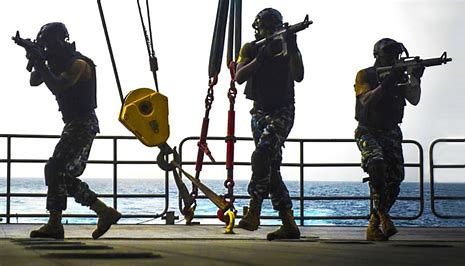Title: Piracy and Maritime Security: Challenges and Strategies for the United States
Abstract:
Piracy poses a persistent threat to maritime security, endangering global trade, regional stability, and human lives. While piracy has historically been associated with the golden age of piracy, modern piracy continues to thrive in various regions, including the waters surrounding the United States. This essay provides a comprehensive analysis of piracy and maritime security in the context of the United States, examining its historical roots, contemporary manifestations, and implications for national security and global commerce. Drawing on case studies, policy perspectives, and expert insights, it explores the drivers of piracy, the impact of piracy on maritime trade, and the strategies employed by the United States and international partners to combat piracy and promote maritime security. By addressing the root causes of piracy and enhancing cooperation among stakeholders, the United States can play a pivotal role in safeguarding the world’s oceans and ensuring the free flow of maritime commerce.

Introduction:
Piracy has plagued the world’s oceans for centuries, threatening the safety of seafarers, disrupting maritime trade, and undermining global security. While the days of swashbuckling pirates may seem like a relic of the past, modern piracy continues to pose a significant challenge to maritime security in the twenty-first century. The United States, as a maritime nation with extensive coastlines and strategic interests in global trade, is particularly vulnerable to the threats posed by piracy. This essay aims to provide a comprehensive analysis of piracy and maritime security in the context of the United States, examining the historical roots of piracy, its contemporary manifestations, and the strategies employed by the U.S. and international partners to combat piracy and promote maritime security.
Historical Roots of Piracy:
The history of piracy is as old as seafaring itself, with piracy dating back to ancient times when pirates preyed on merchant vessels and coastal communities in search of plunder and riches. The golden age of piracy, which spanned the late seventeenth and early eighteenth centuries, saw the rise of notorious pirates such as Blackbeard, Captain Kidd, and Anne Bonny, who terrorized the seas off the coast of North America, the Caribbean, and West Africa. While piracy declined in the nineteenth century due to increased naval patrols and international cooperation, piracy has experienced a resurgence in recent decades, fueled by factors such as political instability, economic deprivation, and the proliferation of illicit activities in maritime chokepoints and lawless regions.

Contemporary Manifestations of Piracy:
Modern piracy takes various forms, ranging from armed robbery and hijacking to kidnapping for ransom and maritime terrorism, with piracy hotspots emerging in regions such as the Gulf of Aden, the Gulf of Guinea, and the waters off the coast of Southeast Asia. Pirates often target vulnerable vessels, including commercial ships, fishing trawlers, and oil tankers, exploiting weaknesses in maritime security infrastructure and evading detection through clandestine tactics. In addition to traditional acts of piracy, cyber piracy poses a growing threat to maritime commerce, with hackers targeting shipping companies, port facilities, and maritime supply chains to steal sensitive information, disrupt operations, and extort ransom payments.
Impact of Piracy on Maritime Trade:
The resurgence of piracy has significant implications for maritime trade, global commerce, and economic prosperity, with piracy-related incidents disrupting shipping routes, inflating insurance costs, and deterring investment in maritime infrastructure. Piracy hotspots such as the Gulf of Aden and the Gulf of Guinea pose particular risks to international shipping, with pirate attacks leading to the hijacking of vessels, the kidnapping of crew members, and the theft of cargo, resulting in financial losses and reputational damage for shipping companies and their insurers. Moreover, the threat of piracy undermines confidence in maritime security, prompting concerns among governments, industry stakeholders, and international organizations about the need for coordinated action to address piracy and promote stability in maritime transit routes.
Strategies for Combating Piracy:

Addressing the root causes of piracy and enhancing maritime security requires a comprehensive and multi-faceted approach that combines deterrence, prevention, and response measures. Key strategies for combating piracy include:
- Naval Patrols and Maritime Law Enforcement: Deploying naval patrols, coast guard vessels, and law enforcement agencies to patrol piracy-prone waters, deter pirate attacks, and apprehend suspected pirates for prosecution under international law.
- Capacity Building and Regional Cooperation: Strengthening the capacity of coastal states to patrol their territorial waters, enhance maritime surveillance capabilities, and prosecute pirates through regional cooperation mechanisms, such as information sharing agreements and joint maritime security initiatives.
- Public-Private Partnerships: Fostering collaboration between governments, shipping companies, and industry associations to share intelligence, coordinate security measures, and implement best practices for mitigating piracy risks and enhancing maritime resilience.
- Legal Frameworks and Prosecution: Enacting and enforcing domestic legislation and international conventions to criminalize piracy, facilitate the prosecution of suspected pirates, and ensure that perpetrators are held accountable for their actions under the rule of law.
- Humanitarian Assistance and Crew Welfare: Providing humanitarian assistance, medical care, and psychosocial support to victims of piracy, including seafarers and their families, who may experience trauma, anxiety, and emotional distress as a result of pirate attacks and captivity.

Conclusion:
Piracy remains a persistent threat to maritime security, endangering the safety of seafarers, disrupting maritime trade, and undermining global stability. The United States, as a maritime nation with strategic interests in global commerce and security, has a vested interest in combating piracy and promoting maritime security in collaboration with international partners. By addressing the root causes of piracy, enhancing maritime surveillance capabilities, and fostering cooperation among stakeholders, the United States can play a leading role in safeguarding the world’s oceans and ensuring the free flow of maritime commerce for the benefit of all nations. Through concerted efforts to strengthen maritime security infrastructure, promote international cooperation, and uphold the rule of law at sea, the United States can contribute to a safer, more secure, and prosperous maritime environment for future generations.
- Legal Framework and International Cooperation: The United States engages in international efforts to combat piracy through various legal frameworks and partnerships. This includes adherence to international conventions such as the United Nations Convention on the Law of the Sea (UNCLOS) and cooperation with regional organizations like the International Maritime Organization (IMO) and the Contact Group on Piracy off the Coast of Somalia (CGPCS). Through these mechanisms, the U.S. collaborates with other countries to develop strategies, share information, and coordinate responses to maritime security threats.
- Military Operations and Naval Presence: The U.S. maintains a significant naval presence in key maritime regions around the world to deter piracy and ensure freedom of navigation. Operations such as Combined Task Force 151 (CTF-151) in the Gulf of Aden and the U.S. Navy’s presence in the Gulf of Guinea demonstrate the commitment to maritime security and the protection of shipping lanes. Additionally, joint exercises with partner nations and multinational naval patrols contribute to enhancing security and stability in vulnerable maritime areas.
- Public-Private Partnerships: Collaboration between government agencies, the maritime industry, and private security firms is essential for combating piracy and enhancing maritime security. Initiatives such as the Maritime Security Program (MSP) and the use of private maritime security contractors (PMSCs) onboard vessels help mitigate risks and provide additional layers of protection against pirate attacks. Moreover, information sharing platforms and industry-led initiatives promote cooperation and best practices for enhancing security measures.

- Technological Solutions: Advances in technology play a crucial role in strengthening maritime security and countering piracy. Technologies such as satellite surveillance, automatic identification systems (AIS), and unmanned aerial vehicles (UAVs) enable maritime authorities to monitor vessel movements, detect suspicious activities, and respond to threats more effectively. Additionally, the use of secure communication systems and encrypted data transmission enhances situational awareness and facilitates coordinated responses to maritime incidents.
- Legal Prosecution and Judicial Cooperation: The United States supports efforts to prosecute pirates and other maritime criminals through legal mechanisms such as the Djibouti Code of Conduct and regional judicial cooperation agreements. By working with partner countries to investigate and prosecute piracy cases, the U.S. helps deter future attacks and strengthen the rule of law in maritime regions. Moreover, capacity-building initiatives assist countries in developing legal frameworks and law enforcement capabilities to address maritime crime effectively.
- Maritime Domain Awareness: Improving maritime domain awareness (MDA) is essential for identifying emerging threats, detecting illicit activities, and protecting maritime assets and infrastructure. Through the deployment of surveillance systems, intelligence sharing arrangements, and collaboration with international partners, the United States enhances its ability to monitor maritime environments, track vessel movements, and respond to security incidents in real-time.
- Environmental and Economic Impacts: Piracy and maritime insecurity not only pose security threats but also have broader environmental and economic consequences. Piracy disrupts shipping routes, increases insurance premiums, and imposes additional costs on maritime trade and commerce. Furthermore, illegal activities such as illegal fishing, smuggling, and marine pollution exacerbate environmental degradation and undermine sustainable maritime development. Addressing these interconnected challenges requires comprehensive approaches that integrate security, environmental protection, and economic development priorities.
- Emerging Threats and Future Challenges: While significant progress has been made in combating piracy, new and evolving threats continue to pose challenges to maritime security. These include the rise of cyber threats targeting maritime infrastructure, the proliferation of unmanned maritime systems (UMS), and the potential for terrorist organizations to exploit maritime routes for illicit activities. Addressing these emerging threats requires proactive measures, investment in technological innovation, and close collaboration between governments, industry stakeholders, and international partners.


